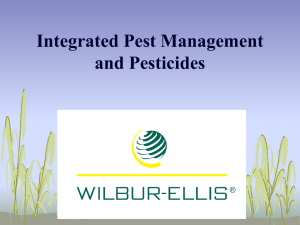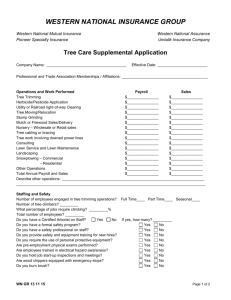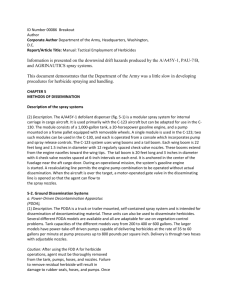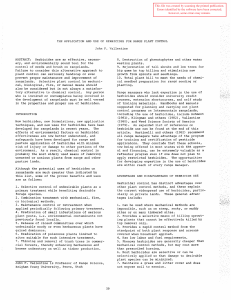Effective Pesticide - Montana Pesticide Safety Education Program
advertisement
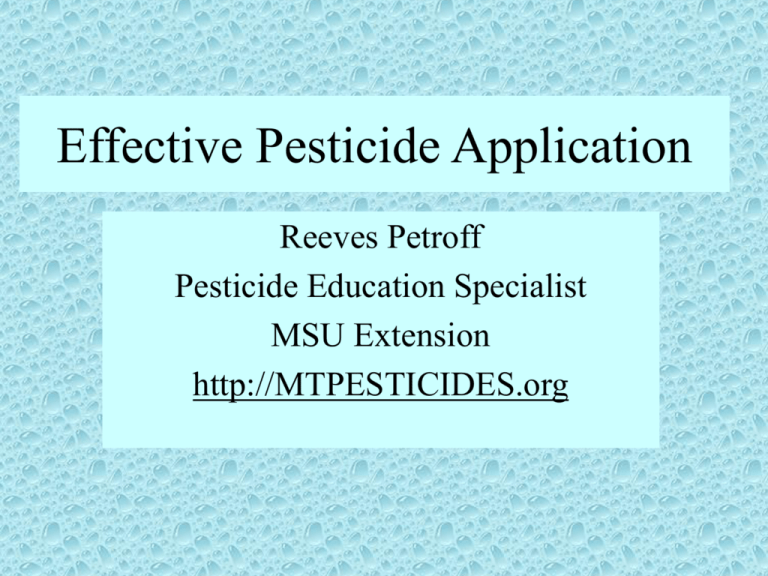
Effective Pesticide Application Reeves Petroff Pesticide Education Specialist MSU Extension http://MTPESTICIDES.org A Basic Understanding of Effective Pesticide Application Should not be Confusing ! Or Painful ! but it can be!! The Pesticide Application Process The Spray Solution Atomization Transport to Target Impaction / Deposition Post-Impact Drop Behavior Spreading, Retention, Penetration, Translocation Contact Action Systemic Action Biological Effect Spray Solution - Water • Primary diluent • Large percentage of spray solution volume • Can have a negative influence on pesticide performance. pH Minerals Acidity / Alkalinity (pH) Affects: a. The chemical stability of some pesticides b. The dissociation and subsequent penetration of weak-acid herbicides c. The physical stability of the formulation upon dilution Chemical Stability of Pesticides as related to pH Many pesticides are unstable under alkaline conditions that is pH levels above 7.0 Alkaline hydrolysis. Stability is usually referenced in terms of “half-life”. What is Meant by the Term “Half-Life”? It is the time required for degradation to 50% of the original amount of the pesticide It is used as a standard to describe the relative stability of a pesticide. Examples of Stability relative to pH Insecticides Bendiocarb Carbaryl Dimethoate Trichlorfon Fungicides Captan Iprodione Half-Life 45 min pH 9 3.2 hrs pH 9 48 min pH 9 63 min pH 8 8.3 hrs pH 7 2 min pH 10 < 1 hr pH 9 Example of Instability Alkaline Hydrolysis produced by high pH Dimethoate At high (alkaline) pH, _ OH ions attack the molecule here S (CH3O)2 - P - S - CH2CONHCH3 Producing S (CH3O)2 - P - OH + H - S - CH2CONHCH3 Molecules that are inactive as insecticides Chlorpyrifos At _high (alkaline) pH, OH ions attack the molecule here N S (CH3O)2 - P - O Cl Cl Cl N S (CH3O)2 - P - OH OH + Cl Cl Cl Examples of pH and Stability Herbicides Clodinafop Diclofop Flumiclorac Half-Life 2.5 hrs pH 9 12 hrs pH 9 6 min pH 9 pH also affects the Ohio group of herbicides Weak Acids - OH Examples of Weak-Acid Herbicides Clethodim (Select) Clopyralid (Curtail) Dicamba (Banvel, Clarity)Endothal Fluazifop (Fusilade) Glyphosate (Round Up, Accord, Ranger, Glyphos) Imazamox (Raptor) Imazapyr (Arsenal) Imazethapyr (Pursuit) MCPA Amine Metsulfuron-Methyl (Ally, Escort) Paraquat Picloram (Tordon) Sethoxydim (Poast) 2,4-D Amine Dissociation of a Herbicide Molecule to an ionic form at Alkaline pH Picloram (Tordon) O CL CL N NH2 O C-OH CL CL CL N NH2 C-O CL At low pH At high pH Neutral Molecule Ionic Molecule _ Dissociation of a Herbicide Molecule to an ionic form at Alkaline pH 2,4 - D CL CL O OCH2C-OH O OCH2C-O CL At low pH CL At high pH Neutral Molecule Ionic Molecule _ Dissociation of a Herbicide Molecule to an ionic form at Alkaline pH CL The effect of pH on Weak-Acid herbicides Want: Neutral or uncharged whole molecule Don’t want: Charged or Ionic form Movement of Ionizable (Weak-Acid) Herbicides Weak-Acid herbicides in an acid environment are not ionized and can freely cross plant membranes, upon entering the alkaline phloem (high pH) they will become ionized. This “traps” the pesticide in the phloem and will subsequently be transported to “active sites” within the plant. Non-ionized pesticides freely cross plant membranes Leaves pH 5 Xylem 150 cm / hr Phloem – 90 cm / hr Roots pH 8 Non-ionized pesticides freely cross plant membranes Movement of Non-Ionized Herbicides Once inside the plant, Non-Ionized herbicides such as atrazine can move freely between xylem and phloem, the xylem moves more rapidly than the phloem so the net movement is in the direction of xylem. Leaves Xylem 150 cm / hr Phloem – 90 cm / hr Roots Start Non-ionized pesticides freely cross plant membranes Source: Nufarm Another Point To Ponder The leaf surfaces of several weed species are alkaline (high pH) Causes dissociation of weak-acid herbicides resulting in reduced uptake The condition is generally limited to broadleaf weeds Surface pH of Weed Leaves Dicotyledons Velvetleaf Redroot Pigweed Catchweed Bedstraw Tall Morningglory Pale Smartweed Common Groundsel Teaweed (Prickly Sida) Wild Mustard Black Nightshade Monocotyledons 8.5 - 8.75 8.1 - 8.2 7.6 - 7.75 8.0 - 8.2 7.5 - 7.6 7.75 - 7.8 8.3 - 8.6 8.4 8.2 (most are nearly neutral at pH 7.0) Management of Leaf Surface pH High leaf surface pH can be managed by utilizing spray solutions that have been acidified. Acidified spray solutions can easily and effectively neutralize or even lower the pH level. Elements of the Management of Water / Spray Solution pH • Know the water pH • Know the susceptibility of pesticide • Use acidifiers or adjuvants with acidification properties to adjust the pH level. Know that some things (copper containing fungicides) should NOT be acidified. • Sulfonyl ureas?? Hard Water Ca++, Mg++, Zn++ NA+, K +, Mn + Fe ++, Fe +++, Al +++ Antagonistic Effects of Hard Water on Glyphosate Molecules Glyphosate and the cations will form a strong complex which is physically large. This can prevent or hinder uptake of the herbicide into the plant, effectively reducing herbicide activity. O Mg++,- - Ca++, O + P - CH2 NH2 CH2 C - O O O Sodium and Potassium = (least effect) Calcium, iron, magnesium and copper have most effect The Effect of Calcium on Herbicide uptake by Setaria faberi Untreated Glyphosate (no Calcium) Glyphosate Nicosulfuron Nicosulfuron (no Calcium) + CaCl2 + CaCl2 Dirt and other stuff Dust: Reduces the wettability and coverage of applied spray. Mineral composition of dust may antagonize some herbicides. Organic matter may bind to some herbicides. Clay constituency can neutralize some herbicides. Exudates: Some weeds called Halophytes (Velvetleaf and Lambsquarter) have salt or chalk glands which exude calcium deposits onto the surface. Water Conditioning Strategies to Prevent Antagonism of Weak-Acid herbicides Removal of antagonistic ions by Ammonium Sulfate Conditioning Acidification to reduce the number of negatively charged herbicide ions, or to select for the ionic charge with the least potential for antagonism. The Pesticide Application Process The Spray Solution Atomization Spray Drift Transport to Target Impaction / Deposition Post-Impact Drop Behavior Spreading, Retention, Penetration, Translocation Contact Action Systemic Action Biological Effect
